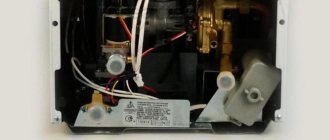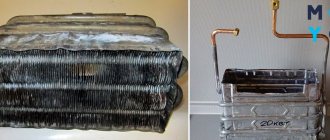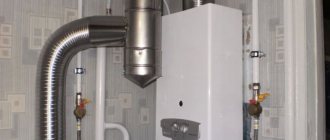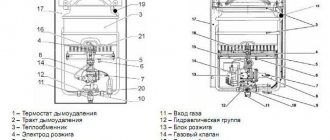A gas water heater is one of the most durable household appliances. With proper use, it can last up to 15 years or more. But in practice, this period may be shorter, which entails the need to purchase new equipment. This is due not only to the physical wear and tear of the components, but also to the obsolescence of the device.
For you, like most owners, replacing a gas water heater in an apartment raises many questions and doubts about the correctness of the actions, doesn’t it? What standards and requirements must be observed so as not to break the law and not put your life and property in danger?
In this article, we will give tips and recommendations on replacing a gas water heater, preparing the necessary documents, and will help you avoid mistakes and miscalculations when installing the device. We will provide our material with diagrams, examples of documents and visual photos, as well as videos.
Basic standards and requirements
Since the device uses highly hazardous fuel, its installation and operation are subject to strict rules and regulations. According to the law, all work, from making changes to the project to connecting the column, must be performed by organizations or specialists licensed for this type of activity.
If the technical documentation is correctly completed and all requirements and conditions are met, dismantling the old and installing a new column is not very difficult.
Owners need to know the basic requirements, who should change their household gas water heater and how, especially owners who are accustomed to organizing their lives independently
The technical conditions for installing a water heater are dictated, first of all, by the safety of using gas equipment. The standards and requirements for replacing an old gas water heater with a new one are stipulated by the manufacturer’s instructions, building codes and gas supply rules SNiP 2.04.08-87*.
No. 1 - premises requirements
A flow-through gas heater is installed in the kitchen or other non-residential premises with a volume of at least 7.5 cubic meters. m, in the presence of air flow through a ventilation grille with an area of 0.03 sq.m.
The ease of removability of the structure also depends on the size of the windows. This means that in the event of an emergency explosion of a gas mixture with air, the excess pressure is neutralized through windows, doors or other provided elements without destroying the building.
The volume of the room, the dimensions of window and ventilation openings must meet the requirements to ensure sufficient air circulation through the water heater
The required window area depends on the thickness of the glass and is determined as follows:
- with a thickness of 3 mm, the area should be at least 0.8 m2;
- for 4 mm – at least 1 m2;
- at 5 mm – from 1.5 m2.
Only the area of the glazing itself should be taken into account without taking into account the frames. The ceiling height must be at least 2 m (with a sloping ceiling of 2.2 m) for devices up to 60 kW, and from 2.5 m for equipment with higher power.
When replacing an old speaker in a bathroom, it is permissible to install it in its original place, although in cases of initial design, according to modern standards, this is prohibited.
It is also necessary to take into account that high humidity leads to corrosion of components and shortens the service life of the device. In this case, it is better to replace the water heater by moving it to a new, more suitable location.
No. 2 - standards for column location
In the passport for the gas water heater or installation instructions, as a rule, the manufacturer indicates the required distances from the device to the building structures of the room. If there are no such instructions, the gas heater is installed based on ease of use, installation, maintenance and repair.
When installing the speaker, you must adhere to the recommended distances from the device body to walls and nearby objects. This will provide the necessary ventilation and eliminate the risk of overheating and fire.
Installation must be carried out in compliance with the distance from the mounting wall, depending on its fire-fighting properties:
- from fireproof materials - at least 2 cm;
- from fire-resistant, combustible, protected by sheet steel, asbestos from 3 mm, plaster, etc. – at least 3 cm.
The dimensions of the thermal insulation must exceed the dimensions of the column by at least 10 cm around the perimeter and 70 cm on top. The distance to the nearest structures, walls, objects should not be less than 15 cm on both sides of the device. If the device data sheet allows installation with a reduced gap, then it is necessary to provide protection for adjacent surfaces with non-combustible materials. But in any case, the gap should not be less than 3 cm.
The burner window should be located approximately at eye level. If the gas heater is installed in a passageway, then a free space of at least 1 m should be provided around it.
No. 3 - requirements for ventilation and chimney
The chimney must ensure complete removal of combustion products naturally with the following volume distribution:
- hoods - at the level of 3 times air exchange in one hour;
- air flow from the room - not less than the total volume of exhaust air and air spent on gas combustion.
For equipment over 60 kW, an additional calculation of the size of ventilation devices is performed.
Also, do not forget about the ventilation of the device itself. Failure to maintain the recommended distance of 15 cm from the side wall will result in insufficient ventilation on the left side of the speaker and local overheating.
Galvanized or stainless steel is recommended as a chimney material. According to the type of design, it can be a sandwich pipe, corrugated pipe or a coaxial chimney in the case of a turbocharged water heater. Aluminum corrugation should not be used due to its susceptibility to rapid burning.
The total length of the pipe, from the top of the column to the opening of the chimney duct in the wall, should not exceed 3 m. In this case, it is necessary to observe the maximum number of turns at right angles - no more than two. If there are more of them, then you should subtract 1 m from the total length for each 90-degree turn and 0.5 m for each 45-degree angle.
The length of the vertical acceleration section of the chimney at the outlet of the column must be at least 25 - 30 cm with a ceiling height of up to 2.7 m. In rooms with a higher ceiling, it is recommended to increase it to 50 cm. The horizontal part is mounted with a minimum upward slope of 2 degrees.
No. 4 - requirements for gas supply hoses
When replacing supply pipes and gas water heater hoses, it is necessary to take into account the gas inspection requirements for their type and material of manufacture.
Flexible hoses for gas are rubber, metal braided, bellows made of stainless steel and polymers, PVC. The main criterion for the correct choice is the presence of a yellow sticker or coloring and a certificate. To avoid fakes, it is recommended to buy them in specialized stores. The most preferable option is a bellows hose or PVC hose.
The dielectric insert significantly increases the safety of using the geyser. This is especially true for apartment buildings, where the likelihood of stray currents appearing in the gas main is quite high.
The length of the gas supply hose should not exceed 1.5 - 2 m with an internal diameter of 15 mm. It cannot be bent or pulled sharply. At the point where the bellows hose is connected to the gas pipe, it is necessary to install insulating adapters to protect both the device itself and the gas pipeline from stray currents and discharges.
Premises requirements
According to current standards, a room for installing a geyser in a private house must meet certain requirements:
…
- room volume - at least 15 m³;
- ceiling height - above 2 m;
- walls must be made of non-combustible materials;
- the presence of an opening window and supply and exhaust ventilation;
- door 0.8 m wide with an opening at the bottom or perforation to ensure air circulation.
If the house is wooden, then additional safety measures will have to be taken in the room for installing a gas water heater. A protective shield made of non-combustible materials (mostly metal) is first hung at the installation site of the device. Its size must exceed the dimensions of the device. It is also advisable to insulate wooden walls with mineral wool or basalt insulation so that the wall does not freeze in winter. A large hole should be made at the point where the exhaust pipe enters the wall; the gap between the duct and the wall is filled with non-combustible material.
Procedure for processing documents
If the installation of a new geyser is planned in the same place and its capacity does not exceed the old one, then such a replacement is carried out according to the sketch, within the framework of the existing project.
To do this, you will need the following list of documents and their copies:
- Gas supply project.
- A certificate confirming ownership of an apartment or house. For the private sector - an act on the right to use a land plot.
- Registration certificate of an apartment or house.
- Report on checking the condition of smoke and ventilation ducts. To receive it, first submit an application to the service authorized in your region (housing and communal services, Ministry of Emergency Situations, firefighters).
- Technical data sheet for a new water heater.
- Application for replacement of a gas water heater without changing its location and power.
Requirements may vary by region.
An example of an application form provided to the gas service for replacement of a dispenser. In some regions, additional requirements may be put forward for the installation of a gas alarm, the prohibition of turbocharged ventilation systems, and others.
In all other cases, for example, when you need to move the water heater to another location or install a more powerful water heater, the development of a new project is required.
The collection of necessary documents occurs in the following order:
- Obtaining a chimney inspection report.
- Submitting an application to Gorgaz (or another specialized organization with which an agreement has been concluded) to obtain technical conditions for replacing a gas water heater.
- After their manufacture, it is necessary to find a design organization to create the project.
- Then the received documentation is approved by the metrological and technical departments of the gas industry.
- 5 days before the start of work to replace the column, you must submit an application for technical supervision. At this stage, you will need to present a report on the condition of the chimney.
- Installation work to replace the water heater is carried out by a licensed organization.
- Connection to the gas system and commissioning of the new water column is carried out by a representative of Gorgaz.
At the final stage, you will have the following list of documents on hand: the project, the act of acceptance of the gas appliance into operation, the act of checking the chimney.
Violating the registration procedure, ignoring it, or trying to somehow circumvent it is a bad idea. As soon as illegal replacement/installation of equipment is detected, the violator will face a fine
Going through the paperwork may seem like a rather long-term and costly procedure. But the competition that has appeared in recent years in the market for the provision of maintenance services for VDGO and VKGO contributes to its acceleration and simplification. In addition, all attempts to circumvent it, in most cases, are even more expensive.
Installation of a geyser
You should know that changing the location of the device, as well as its initial installation, is a labor-intensive and high-cost process, in contrast to replacing an old geyser with a new one while maintaining the same location.
To install the column you need to collect the following documents:
- An act confirming the serviceability of the chimney system and ventilation of the premises. It is obtained from the fire department.
- Obtain permits from Gorgaz for installation work in compliance with the project.
- Make a project for installing equipment.
- Technical data sheet for the device.
- Submit an application for repair/replacement of water and gas mains.
- Submit an application to the city administration for redevelopment and reconstruction of communications.
- After installation, you need to provide the installation project to the BTI.
After receiving and collecting all the documents, a Gorgaz employee will connect to the gas pipe, connect the meter and seal it.
Who is allowed to replace the column?
Often, when faced with the need to replace a gas water heater for the first time, its owners have a fair question: is it possible to connect a new gas water heater instead of the old one?
An unequivocal answer to this is given by the Decree of the Government of the Russian Federation No. 410 of May 14, 2013, which states that independent replacement of gas equipment is prohibited. It should only be carried out by specialized organizations with which an agreement has been concluded for the maintenance of gas appliances. Lists of companies with which such an agreement can be concluded are published in the notification registers on the regional websites of the State Housing Inspectorate.
A commissioning certificate must be issued for the installed gas water heater. In its absence, a fine of 10–15 thousand rubles is imposed. (according to Article 7.19 of the Code of Administrative Offenses of the Russian Federation). If an unauthorized connection leads to damage to property and people’s lives, criminal liability may arise, as stated in the Criminal Code of the Russian Federation.
You can choose an organization to enter into a contract for the maintenance and repair of VDGO and VKGO based on ratings, reviews, and study of permits
In addition, independent replacement will not allow you to put a new column under warranty. The organization that carried out the installation makes entries in the device passport and seals them. Only after this the dispenser is considered accepted for service and subject to warranty service.
In addition to the responsibilities to comply with standards and requirements, owners have the right to independently choose an organization to create a project and carry out installation work. The main condition is that they have the appropriate licenses.
All work related to the gas supply system can only be performed by specialists who have the appropriate permit to work with gas equipment and have passed annual recertification.
Recommendations for choosing a new speaker
The main parameters when choosing a geyser are power and performance. They should be given priority attention if you do not plan to redo the project when installing the column in its original place. The power of the new device should not exceed that specified in the project.
For a family of 1 - 2 people, a dispenser capacity of 10 liters per minute is usually sufficient, which corresponds to a power of 17 - 18 kW. If replacing the device is associated with the desire to use two points of water consumption at the same time, for example, a sink and a shower, then the productivity of the gas heater should be at least 13 l/min.
For three points, including filling the bathtub, you need to focus on 15 l/min. Provided there is sufficient pressure in the water supply.
When choosing a new water heater, it is important to decide whether the previous power of the water heater is enough for the needs of the family or whether you will need to purchase a more efficient device, which will entail the need to order a new project
Many models of geysers have a flame modulation function. Its purpose is to maintain a constant temperature (with an accuracy of 1 - 3 degrees) at the outlet of the device, regardless of water consumption. Choosing such a model will allow you not to worry about adjusting the temperature when several family members turn on hot water at the same time.
Before installing the column, you need to check the condition of the chimney, pipelines, taps, and determine which elements will require updating.
Installation of a new column
It is better to trust the work to professionals. But many owners of private houses, having some experience, can do this on their own, but subject to important points:
- choose a place that should have already been described earlier (at least 15 cubic meters);
- mark the wall to place fasteners;
- fasten the dowels based on the attached instructions (take into account the weight of the column in working condition);
- hang the column on the fasteners;
- install filters for water purification;
- embed (if necessary) connect the taps;
- if there is none on the pipe, then install a tee or fitting;
- installation, soldering of other necessary taps;
- connect the column to the water supply system;
- connect to the gas supply system;
- connect the corrugation to the chimney;
- check connections for leaks (using soap).
Important! Test run the equipment only in the presence of a gas service employee.
A gas service employee will not only control the startup of the equipment. If everything is done correctly, he draws up an act on the basis of which permission to use the dispenser is issued. Launching without permission is not only dangerous to life, but also faces serious fines. You should not endanger your life and the lives of your loved ones.
Typical mistakes when replacing a column
Often, when installing a water heater in a new location, the lateral distances of 150 mm from the wall or other surfaces and objects are not observed.
Too close a distance to the gas tap will make it difficult to maintain and will cause failure during commissioning
Excessive heating accelerates the wear of the heat exchanger, promotes the formation of scale, leaks, and reduces the service life of the gas appliance. We recommend that you read the heat exchanger repair instructions.
Many errors are associated with the use of unauthorized gas supply hoses or their incorrect connection. The desire to save on the price of such an important element can lead to unpleasant consequences.
It is known that exposure to gas greatly accelerates the drying of rubber. If it is not intended for gas line use or is of poor quality, the hose will quickly crack, causing unacceptable gas leakage.
Sometimes, in an effort to give the most aesthetic appearance to the kitchen interior, the column is placed in wall cabinets. This arrangement, in addition to overheating the column itself, can lead to more serious consequences.
Installing a gas water heater in a lockable cabinet disrupts the normal operating temperature of the device. Impedes the flow of outside air. Insufficient ventilation increases the risk of carbon monoxide poisoning
To improve air circulation, the partitions at the bottom and top of the column should be removed. If the required gap of 3 cm is not observed and the side surfaces are protected with fireproof materials, heating the cabinet walls can lead to their charring and fire.
We recommend that you familiarize yourself with the best ideas for disguising a speaker in the kitchen that do not violate safety requirements.











